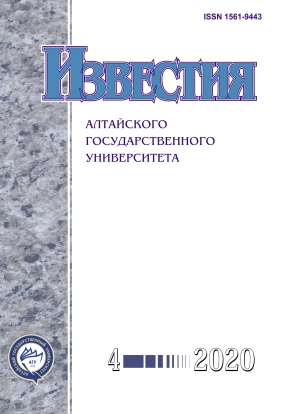Computer Simulation of Small Magnetic Clusters of 3d-Transition Metals of the Iron Subgroup Using the Hybrid Density Functional Method
УДК 53:004
Abstract
This paper presents the results of s study focused on the stability of small 3d-transition-metal magnetic clusters (metals of an iron subgroup) in spin-polarized states using the hybrid density functional method. Computer modeling and full variational optimization of geometric structures of clusters were performed for various values of the spin multiplicity of electronic states. The binding energies, the bond lengths, and the frequencies of atomic zero-point vibrations in small clusters with a nuclearity of n = 2, 3, 4, 5, 6 were calculated depending on the metal (Fe, Co, Ni) and spin multiplicity M in the zero-charge state. The calculations were carried out using the hybrid density functional B3LYP method in the def2-TZVP basis set of the ORCA package algorithms. A comparison of the calculated results with the available experimental data is presented. It is shown that the calculated data obtained by the hybrid density functional method are in satisfactory agreement with the experimental data for “naked” clusters in inert media both for the spin multiplicity of the ground state and for the energy of atomic shock dissociation of clusters in inert gas flows.
Downloads
Metrics
References
Armentrout P.B., Hales D.A., Lian L. Collision-Induced Dissociation of Transition Metal Cluster Ions // Advances in Metal and Semiconductor Clusters; Duncan, M.A., Ed.; JAI: Greenwich, 1994. Vol. 2.
Lian L., Su C.-X., Armentrout P.B. Collision-induced Dissociation of Nin+ (n = 2 - 18) with Xe: Bond Energies, Geometrical Structures, and Dissociation Pathways // J. Chem. Phys. 1992. Vol. 96. DOI: 10.1063/1.462406.
Lian L., Su C.-X., Armentrout P.B. Collision-induced dissociation of Fen+(n = 2-19) with Xe: Bond energies, geometric structures, and dissociation pathways // J. Chem. Phys. 1992. Vol. 97. DOI: 10.1063/1.463912.
Hales D.A., Su C.-X., Lian L., Armentrout P.B. Collision-induced Dissociation of Con+ (n = 2 - 18) with Xe: Bond Energies of Cationic and Neutral Cobalt Clusters, Dissociation Pathways, and Structures // J. Chem. Phys. 1994. Vol. 100. DOI: 10.1063/1.466636.
Castro M., Jamorski C., Salahub D.R. Structure, bonding, and magnetism of small Fe., Con, and Niclusters, n <5 // Chemical Physics Letters. 1997. Vol. 271. DOI: 10.1016/S0009-2614(97)00420-X.
Lombardi J.R., Davis B. Periodic Properties of Force Constants of Small Transition-Metal and Lanthanide Clusters // Chem. Rev. 2002. Vol. 102. DOI: 10.1021/cr010425j.
Perez M., Munoz F., Mejia-Lopez J., Martinez G. Physical and chemical properties of Co n-m Cu m nanoclusters with n = 2-6 atoms via ab-initio calculations // J. of Nanopart Res. 2012. Vol. 14. DOI: 10.1007/s11051-012-0933-2.
Gutsev G.L., Belay K.J., Gutsev L.G., Weatherford C.A. Modification of Magnetic Properties of Iron Clusters by Doping and Adsorption From a Few Atoms to Nanoclusters // Modification of Magnetic Properties of Iron Clusters by Doping and Adsorption. SpringerBriefs in Molecular Science. Springer, Cham, 2016. DOI: 10.1007/978-3-319-27886-5_1.
Becke A.D. Density-functional thermochemistry. III. The role of exact exchange // J. Chem. Phys. 1993. Vol. 98. DOI: 10.1063/1.464913.
Lee Ch., Yang W., and Parr R.G. Development of the Colle-Salvetti correlation-energy formula into a functional of the electron density // Phys. Rev. 1988. Vol. B 37. DOI: 10.1103/PhysRevB.37.785.
ORCA, An Ab Initio, DFT and Semiempirical electronic structure package. Version 4.2.0. Department of theory and spectroscopy. Directorship: Frank Neese. Max Planck Institute fuerKohlenforschung, Kaiser Wilhelm Platz 1, D-45470 Muelheim/Ruhr, Germany. 2019. URL: www. orcaforum.kofo.mpg.de.
Izvestiya of Altai State University is a golden publisher, as we allow self-archiving, but most importantly we are fully transparent about your rights.
Authors may present and discuss their findings ahead of publication: at biological or scientific conferences, on preprint servers, in public databases, and in blogs, wikis, tweets, and other informal communication channels.
Izvestiya of Altai State University allows authors to deposit manuscripts (currently under review or those for intended submission to Izvestiya of Altai State University) in non-commercial, pre-print servers such as ArXiv.
Authors who publish with this journal agree to the following terms:
- Authors retain copyright and grant the journal right of first publication with the work simultaneously licensed under a Creative Commons Attribution License (CC BY 4.0) that allows others to share the work with an acknowledgement of the work's authorship and initial publication in this journal.
- Authors are able to enter into separate, additional contractual arrangements for the non-exclusive distribution of the journal's published version of the work (e.g., post it to an institutional repository or publish it in a book), with an acknowledgement of its initial publication in this journal.
- Authors are permitted and encouraged to post their work online (e.g., in institutional repositories or on their website) prior to and during the submission process, as it can lead to productive exchanges, as well as earlier and greater citation of published work (See The Effect of Open Access).








